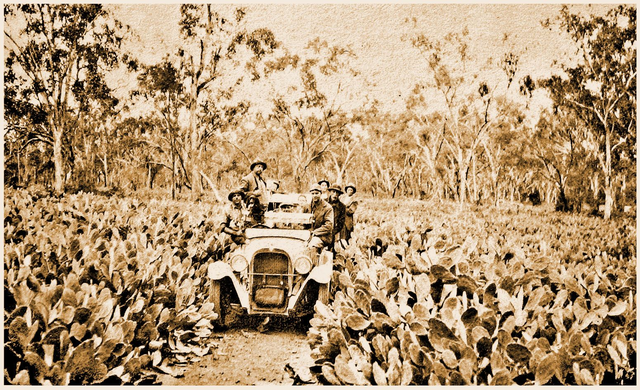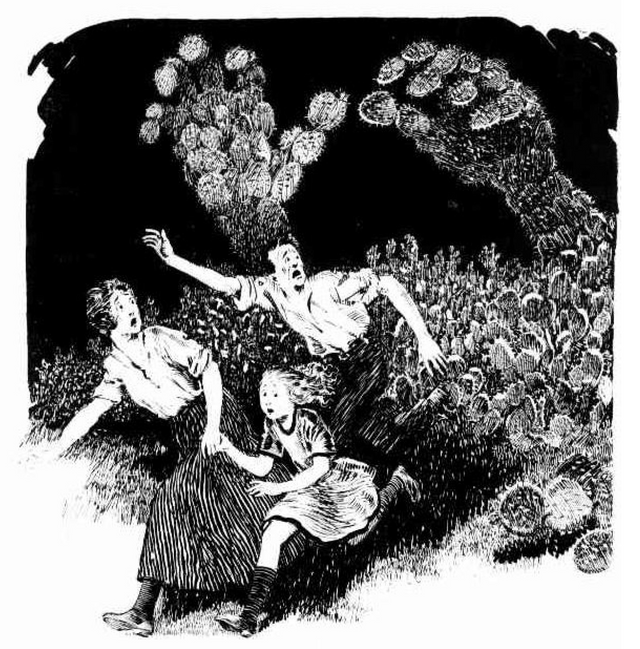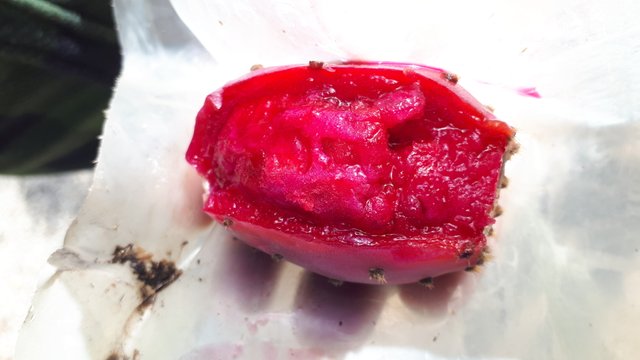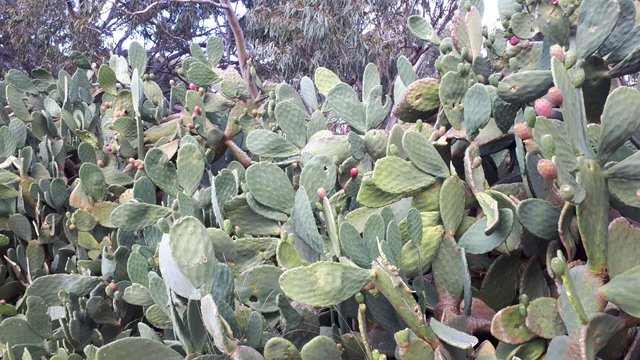🌵 The Nopal Cactus: Neither Food nor Medicine, But Terrifying Invader (An Australian Perspective)🌵
Ah, our lovely colonial island home, where migrants and scientists alike brought species this land had never before seen, enhancing what was already here stuffing up the place with foxes in a place with no other primary predator, feral cats, rabbits (which, incidentally, were released not a kilometre from where I live), cane toads and invasive plants. No wonder our border control is seen as so important. These days we are more cautious about biological imports. History has told us it's not such a good idea.
One of these unwelcome guests were the prickly pear, known in South America as the nopal cactus. To me, it was reminscent of the suburban Western Suburbs of Melbourne where I grew up until I was about ten years old, where the wasteland of dry paddocks stretched into no man's land of rusting barbed wire, rotting fence posts, rabbit warrens, scotch thistles and box thorns. Prickly pear was not for falling in, and god forbid you tried to pick one of it's crimson fruits, lest you became like the echidna, quilled with spikes. For the huge Maltese community in that area, however, the prickly pear was a delicacy, according to my father. And he was right - like Mexico where an eagle perches atop a nopal cactus, one of the Maltese coat of arms is said to have a prickly pear. Like many things, he waxes lyrical about that taste of childhood where he and his brothers shot rabbits to sustain the family diet in a poor migrant family along with the rest of them that came out post war.
The prickly pear has become part of Australia's history, despised rather than revered as a food or a natural medicine - to me, it is unfathomable that it could be used for a medicine or to make vegan tacos. And so this post becomes part one of an inquiry into this invasive pest, because not ten miles from here there is a hedge of it, and my curious nature is piqued.
In 1787, Opuntia monacantha was introduced here from Rio de Janeiro, here to develop the cochineal industry as they were host for this particular industry. Landowners grew hedges of it around their homesteads until they proliferated so much they were hacked down. They adapted quickly to the lesser rainfall than their native home, and by 1900, over 10,000,000 acres in Queensland and New South Wales were invaded by this migrant plant. By 1925, there was over six times that amount by some estimates. From one imported cutting, we ended up with multitudes - 'equivalent to the whole land area of the United Kingdom or New Zealand'.1

Fancy a drive through the cactus fields, anyone?
To me, adding to this gothic horror story that seems a queer mix of John Wyndam of Triffid fame and perhaps something more gothic colonial like Henry Lawson, the attempts at eradication send chills down one's spine:

Forget about sharks - the prickly pear was the larger menace! Image from The Sydney Mail, 1923
In the end, they were offering 1.3 million to anyone who could solve the problem. The government, only just formed in 1901, sent scientists all over the world, where they finally found a moth that obliterated it with millions of larvae.
The invaded land was reclaimed, much of which was given to returned soldiers who had their own nightmares on land that was largely unworkable - but that's another story.
The discovery of the prickly pear hedge in the town over from me in the Autumn as the fruits sit tantalizingly pink in the sunshine was exciting in many ways. I have read so many posts here about the benefit of nopal, but have skimmed over them because the word did not summon up the vision of prickly pear from my childhood and the historical cultural memory of Australia. Reluctantly, my man picked me a fruit, using a strip of plastic from a nearby tree guard and using his credit card to slice it.
 !
!

The Maltese didn't do that, I know - they soak it in water to soften the spikes and scrub them off - but we are out walking, and I am impatient and excitable as always. I relish it - it does taste of summer, watery and refreshing after a long walk. But what excites me is that I know it's a natural medicine, and I'm about to go off on another journey of exploration.
Of course, my man is spiked, and tries to suppress his annoyance, knowing how I needed to know, to taste, to experience, to satiate my curiosity.
What do you know about the prickly pear?
Do you use it as a medicine?

@naturalmedicine II Discord Invite II #naturalmedicine

Website | @homesteaderscoop | Discord Community


Discord 🧘About

It's been here since 1787? Wow
Posted using Partiko Android
Yeah I know right!!!! How's that picture with the car driving through a field of it. There's some awesome historic photos!
Yeah. That pic is just great. In season they're one of my favourite wild foods. I roast some and juice some and steam juice some more...Ive written posts on them in the past. Nor sure of the Steemit links but here's one on our blog:https://ligayagarden.online/plants-in-the-wild/prickly-pear-opuntia-species/
goodness, that is just incredible, that is quite the invasion. Quite fascinating! I've always wanted to taste prickly pear.
I'm afraid my climate wouldn't support prickly pear, but we have many invasive species of our own! Maybe I could send you a few? Ha ha ha! I remember hearing about the invasive species problem in Australia. I'm sure every continent has its own version by now. Some things are good to share, some things we should just keep to ourselves!
I'm still trying to pick up my jaw on the idea that solution of slaughtering native birds was thought appropriate!
I often think that getting an acceptance that some of these invasive species are good food sources would work much better as control methods than anything currently in place. Rabbit, carp and prickly pear would certainly be worth trying. Make it a delicacy which is offered at a high price in the best restaurants and people will throw money at it, creating a market for hunters and foragers.
Posted using Partiko Android
Exactly. In England I used to go to this great pub that had rabbit pie... it was extraordinary. And peasant too. Aussies have so many wild deer and you can't even get a venison at the local pub!!!
Posted using Partiko Android
People usually think they're "enhancing" things by adding/modifying whatever they want and then cry ignorance when it fails catastrophically (in the case of things like this, when it's much smaller like a muffed artwork you can at least hide it unless you're livestreaming XD).
I knew the prickly pear was edible/medicinal only because JJ said it was. We've never actually gotten around to using it for either. Am pretty sure there's some growing around here too, but in single plants rather than hedges.
Ah, if they're single plants they'll be hedges before long! Whereabouts are you again mate - I think I should know, but forgot!!
LoL no worries, if it's any consolation I'm usually only vaguely aware of what country people in (and sometimes not even then!) unless I talk to them often enough or it comes up often enough in their posts to sink in XD
Imagine trying to keep track of where your friends are in the future when humans are scattered across various planets and moons and space stations and things O_O
Oh man yeah that would be so weird!! Hi mate, sorry, you're in the galaxy to the left of that other galaxy right? Man it's been LIGHT YEARS since we've caught up. What, it's not that one? My bad....
Posted using Partiko Android
Now that is one insane story. Killing the birds and eggs to resolve the problem??? Nutters.
Looking forward to learning what are benefits! No doubt there are many. The elders of south america will have some wisdom on that one.
Prickly Pear is a bit like morning glory - revered here in Thailand as an incredible nutritional food (and soooo yum! and yet classified as a noxious weed in Australia. Had Australia all along been able to use, enjoy and benefit from this amazing and abundant food, it would never have become so invasive. It's the Aussie reluctance, methinks, to embrace difference that has caused it to become the environmental pest it is. Ironically, pineapples (originally central american) are equally invasive here in Thailand, NOT native and yet were embraced and have become "local" and appreciated.
Leading the curation trail for both @ecotrain & @eco-alex.
Together We’re Making This World A Better Place.
Click Here To Join the manually curated trail "@artemislives" to support quality eco-green content.
@ecoTrain
I have seen the plants in wild here in my country but never saw the fruit. You said it correct on one comment, people here in my country- Bangladesh including me don't know about the medicinal use of nopal cactus.
Thanks for sharing!
Hi @riverflows!
Your post was upvoted by @steem-ua, new Steem dApp, using UserAuthority for algorithmic post curation!
Your UA account score is currently 5.712 which ranks you at #502 across all Steem accounts.
Your rank has dropped 2 places in the last three days (old rank 500).
In our last Algorithmic Curation Round, consisting of 182 contributions, your post is ranked at #33.
Evaluation of your UA score:
Feel free to join our @steem-ua Discord server